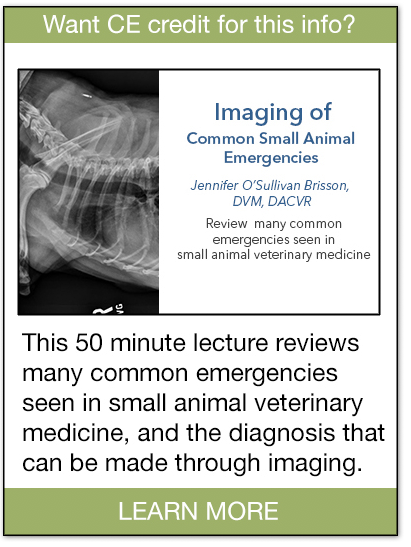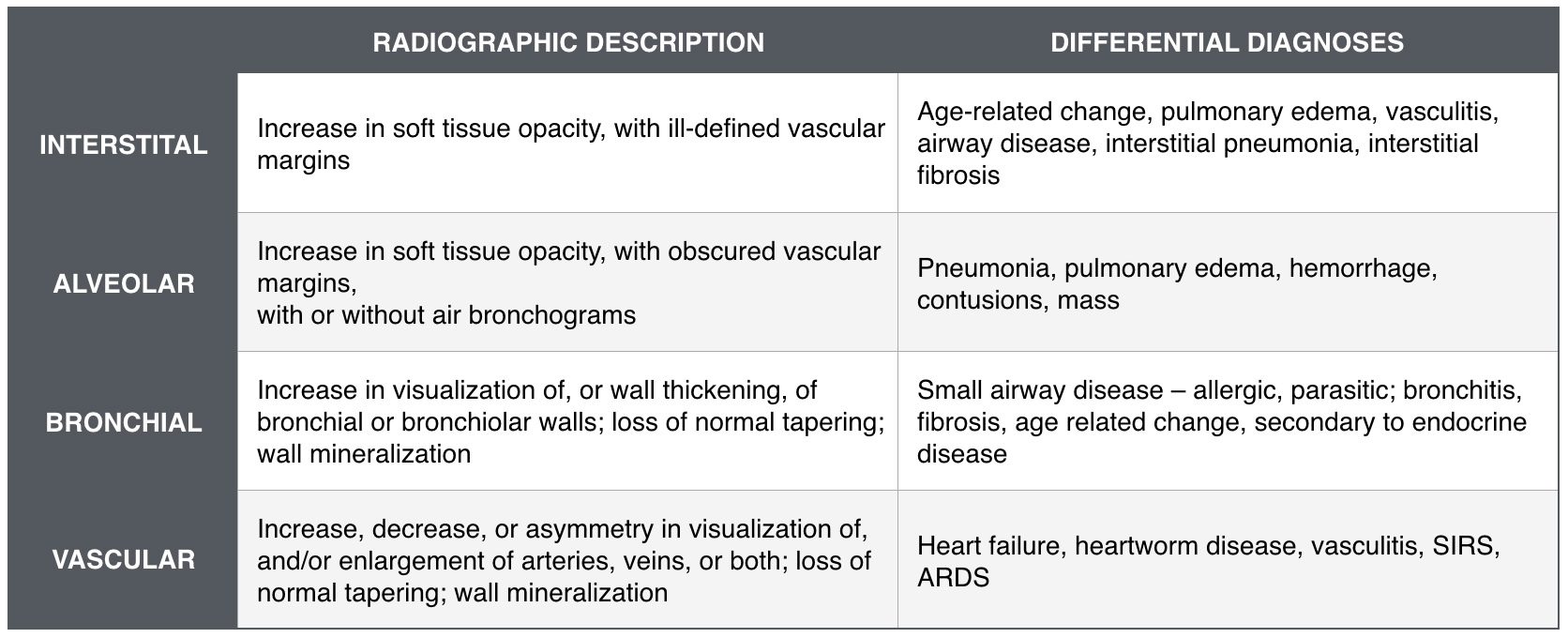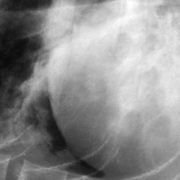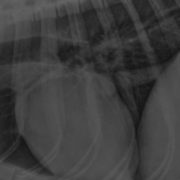Imaging diagnosis of common gastrointestinal and respiratory emergencies
Jennifer O. Brisson, DVM, DACVR
Massachusetts Veterinary Referral Hospital
Posted on 2017-04-18 in Diagnostic Imaging
An accurate and expedient diagnosis to common emergencies in small animal private practice is paramount to successful treatment and outcomes. Beyond the physical examination, initial diagnostics often consist of bloodwork and radiographs. Interpretation of radiographs, or any additional diagnostic imaging studies, should be performed in a systematic manner to ensure evaluation of all structures and consideration of all possible diagnoses.
There is no one correct way to evaluate a radiograph. The key is to approach the study the same way every time. Different approaches include:
- By body system
- Abdominal – Gastrointestinal, hepatobiliary, urogenital, etc
- Thoracic – Cardiovascular, pulmonary, mediastinal, pleural
- From the external structures to internal (or vice versa) – soft tissues, osseous structures, internal organs, serosal detail, pleural/ peritoneal space
- Find the abnormality, then evaluate all the other structures
- Evaluate from right to left, or from top to bottom
The Vomiting Patient
 The diagnosis of an underlying cause in the vomiting patient often begins with abdominal radiographs. A standard abdominal series consists of two images, a right lateral and ventrodorsal view. The third view of the abdomen, the left lateral view, is often acquired and is most useful in evaluating the gastric pylorus and proximal duodenum. A dorsoventral view provides very limited information of the abdominal structures and is not routinely recommended.
The diagnosis of an underlying cause in the vomiting patient often begins with abdominal radiographs. A standard abdominal series consists of two images, a right lateral and ventrodorsal view. The third view of the abdomen, the left lateral view, is often acquired and is most useful in evaluating the gastric pylorus and proximal duodenum. A dorsoventral view provides very limited information of the abdominal structures and is not routinely recommended.
The normal gastric position on the lateral view is perpendicular to the thoracic spine and parallel to the ribs. Cranial deviation of the gastric axis is seen with reduced hepatic size (microhepatia). Caudal and/or lateral displacement of the gastric axis is seen with enlarged hepatic size, and varies with diffuse versus lobar enlargement. Differential diagnoses for cranial or caudal deviation of the stomach also differ with the age of the patient. Microhepatia may be seen with portosystemic shunt, microvascular dysplasia, diaphragmatic hernia or anomalous conformation of the liver, diaphragm, or thoracic wall in patients of any age. Chronic inflammation and fibrosis can lead to microhepatia in the older patient.
Hepatomegaly is defined as extension of the caudal hepatic border beyond the costal margin. Hepatomegaly is a very non-specific finding and may be seen with inflammation, endocrine disease (diabetes mellitus, hyperadrenocorticism), drug hepatopathy (prednisone, phenobarbital), and hepatotoxins. Neoplasia may cause diffuse enlargement (such as seen with a round cell tumor – lymphoma, mast cell) or lobar enlargement (carcinoma, hemangiosarcoma).
Generalized gastric distention, as seen with gastric outflow obstruction or proximal intestinal mechanical ileus may displace the overall gastric axis caudally. Gastric dilatation and volvulus is recognized by the typical displacement of the pylorus cranially and dorsally, with rotation along the long axis.
Intestinal ileus is defined as a disruption of normal intestinal propulsive motility, usually accompanied by distention of the small intestine with fluid, gas, or other contents. In general, the normal canine patient will have variable fluid and gas contents in the small intestine at any given time. In the normal feline patient, the small intestine does not usually contain gas.
Intestinal ileus is divided into the two broad categories of functional and mechanical. Functional ileus usually results in diffuse intestinal distention. Mechanical ileus is associated with an obstructive disease process, and most often results in a focal or segmented pattern of distribution. Foreign material may be seen as atypical gastric or intestinal contents of variable radiopacity (radiolucent, soft tissue, mineral or metallic) on initial and serial radiographs. If mechanical ileus is suspected, and surgery or additional diagnostics, such as ultrasound or an upper gastrointestinal contrast series, is not pursued, then follow up abdominal radiographs are recommended. The timeframe to assess for the progressive transit of intestinal contents on follow-up radiographs is 4-6 hours.
The Respiratory Patient
A standard series of radiographs of the thorax consists of two views, the ventrodorsal (VD) or dorsoventral (DV) view and a lateral view (usually the right). A three view series of the thorax, often referred to a metastatic series, incorporates the left lateral view.
Positioning of the patient influences the appearance of the intrathoracic structures. In the dependent hemithorax, the pulmonary parenchyma is less well aerated and increases in opacity, and may obscure lesion visualization.
 |
Pulmonary Patterns
Evaluation of the pulmonary parenchyma is most often characterized by the pulmonary pattern present. Mixed patterns can be present with many disease processes. Examples of common differential diagnoses for the different pulmonary patterns are included below.
 |
Cardiomegaly
Normal cardiac size in dogs is defined as the cardiac silhouette less than 3-3.5x width of intercostal spaces on the lateral view, and less than 50% of the thoracic cavity volume on the VD or DV view. Normal cardiac size in the cats is defined as less than 2-3x width of intercostal spaces on the lateral view, and less than 50% the thoracic cavity volume on the VD or DV view at the 9th intercostal space. Additional radiographic signs of cardiomegaly for both species include deviation of the cardiac axis, alteration of the cardiac silhouette shape, dorsal deviation of the carina, and displacement of other mediastinal structures.
Cardiac size and shape varies with breed conformation. Deep, narrow chested breeds, such as Dobermans, have a more elongated appearance (more upright position) and relatively small hearts for the size of the surrounding lung volume. Barrel-chested breeds, such as Shih Tzus, have a more rounded appearance and relatively larger hearts. Understanding anatomic variants is key to radiographic interpretation.
The vertebral heart score (VHS) may be employed to give an objective assessment of cardiac size, compared to vertebral body length. The VHS is obtained by measuring the length of the long axis of the heart from the carina to the apex, and then measuring the maximal width of cardiac silhouette perpendicular to the length. These measurements are then compared to vertebral length, by measuring from the cranial aspect of the vertebral body of T4. A normal vertebral heart score in the dog is less than 10.5, and in the cat is less than 8.
About the author
Dr. Brisson has received extensive training in all modalities of veterinary radiology, including magnetic resonance imaging (MRI), computed tomography (CT), radiography, nuclear medicine, and ultrasound. Her professional interests in diagnostic radiology include abdominal MRI, gastrointestinal and hepatobiliary ultrasound, and thoracic computed tomography. Dr. Brisson also has a strong professional interest in Interventional Radiology. Dr. Brisson joined the radiology department at Massachusetts Veterinary Referral Hospital in July 2009. In 2014 she was promoted to Assistant Medical Director for the surgical services. |


 Dr. Brisson received her Doctor of Veterinary Medicine with thesis, from Tufts University, Cummings School of Veterinary Medicine in 2004. She completed a one year internship in small animal medicine and surgery at the Veterinary Referral and Emergency Center in Norwalk, CT, followed by a three year residency in Diagnostic Imaging at Tufts University in July of 2008. Dr. Brisson became board certified by the American College of Veterinary Radiology in September 2009.
Dr. Brisson received her Doctor of Veterinary Medicine with thesis, from Tufts University, Cummings School of Veterinary Medicine in 2004. She completed a one year internship in small animal medicine and surgery at the Veterinary Referral and Emergency Center in Norwalk, CT, followed by a three year residency in Diagnostic Imaging at Tufts University in July of 2008. Dr. Brisson became board certified by the American College of Veterinary Radiology in September 2009.








